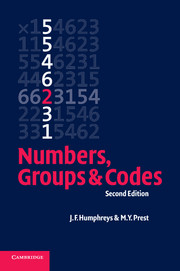Book contents
- Frontmatter
- Contents
- Preface to first edition
- Preface to second edition
- Introduction
- Advice to the reader
- 1 Number theory
- 2 Sets, functions and relations
- 3 Logic and mathematical argument
- 4 Examples of groups
- 5 Group theory and error-correcting codes
- 6 Polynomials
- Appendix on complex numbers
- Answers
- References and further reading
- Biography
- Name index
- Subject index
Appendix on complex numbers
Published online by Cambridge University Press: 05 September 2012
- Frontmatter
- Contents
- Preface to first edition
- Preface to second edition
- Introduction
- Advice to the reader
- 1 Number theory
- 2 Sets, functions and relations
- 3 Logic and mathematical argument
- 4 Examples of groups
- 5 Group theory and error-correcting codes
- 6 Polynomials
- Appendix on complex numbers
- Answers
- References and further reading
- Biography
- Name index
- Subject index
Summary
The reader will be accustomed, from an early age, to the idea of extending number systems. The natural numbers are used for counting, but it soon becomes clear that questions involving natural numbers may not have answers which are natural numbers. For example: ‘On a winter's day, the temperature is 6°C. At night the temperature falls by 10 degrees. What is the overnight temperature’? To deal with this problem, we extend the natural numbers to the set of integers, by including negatives. However, one soon meets integer equations with non-integer solutions. For example: ‘Share 3 cookies between two people’ (that is, ‘Solve 2x − 3 = 0’). Again, we extend our number system from integers to rationals (by including fractions). Even after extending to rationals, there are still unanswered questions. ‘Find the ratio of the length of a diagonal of a square to the length of a side’ (that is, ‘Find x such that x2 = 2’). This time we extend the rationals to the real numbers. It is usual to make do with the real number system for everyday life and for a good part of school life. As we have seen, however, a polynomial like x2 + 1 cannot have real number zeros, since the square of a real number is never negative.
- Type
- Chapter
- Information
- Numbers, Groups and Codes , pp. 292 - 295Publisher: Cambridge University PressPrint publication year: 2004

